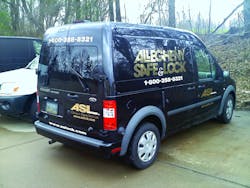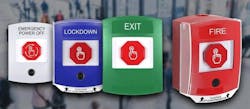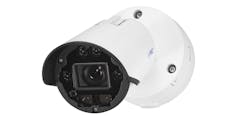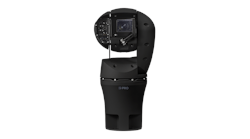Transitioning To Electronics: Getting Started In CCTV
For the second article in our series on locksmiths who are successfully transitioning to electronics, Locksmith Ledger interviewed Tony Demino, president of Allegheny Safe & Lock, Pittsburgh, PA, web site www.aslock.com.
Since 1979, Allegheny Safe & Lock has been providing security for the tri-state area. The company has grown from a locksmith service company to a system integrator specializing in the educational sector.
Following are Locksmith Ledger’s questions and Demino’s answers.
We wanted to speak with a locksmith who made the successful transition to electronic security. Did you begin as a locksmith?
My grandfather had a lock company called Allen & Co and I started working there when I was a kid, rebuilding door closers. I did service work and wound up pushing a truck around the street for years. The company was sold eventually and I decided to go off on my own.
Did you perform all aspects of lock work there?
At Allen & Co we did strictly commercial business in the city of Pittsburgh. I was used to doing work for real estate companies and banks; I got pretty good at safe work. When I got into my own business, there weren’t many locksmiths in the city and at the beginning I depended on the overflow of others to keep me going. I was like many other locksmiths at the start, underfunded and didn’t know anything about running a business.
What was your favorite part of locksmithing back then?
Safe work, I really loved doing it. I won’t say I was good but I really enjoyed it. It was a great challenge. I was 23 years old and fearless; I didn’t really care if I failed. Every year I did a little better and eventually brought my brother on board. We were chugging along with incremental increases every year.
Were you doing any electronics?
When I was still with Allen & Co, Westinghouse was one of our customers and they were big in Pennsylvania. Schlage electronics came out with a proximity device that had a neoprene reader, a disc, connected to a controller using RG59 coax. There was no real control but you could use a card instead of a key! This was back in 1976. There was no real respect for electronics back then. You used a simple series circuit and you pushed a button and that was it. They wanted to control a door with readers from both sides. I built a box out of potted relays.
How did you learn to do that?
I just figured it out. I understood what was going on when you presented a card to the neoprene reader. It closed a circuit. Once it closed the circuit, there had to be subsequent relays I could tie this thing to in order to do what we wanted it to. That was very much the beginning and very primitive. We worked with mag locks in the beginning on computer rooms.
Were you coming up with electronic solutions often at the beginning?
Electronics was very much in its infancy then. You have to realize that the big players then were the alarm companies. We did a lot of strike installations as subcontractors to them, but they didn’t really understand that part of it either because they were burg people. If you wanted to get into a door, they could hang a reader onto a panel and configure it and that would get you in but they really couldn’t go any further than that. In the 80s, that’s a lot of what we did for them.
What made you guys unique? Why would someone choose you for that kind of work?
We knew doors and frames and hardware - that’s what made us unique! They would come to us and say they have this rim device or cylindrical lock or concealed vertical rod device and ask how to electrically operate it and we would come up with the solution at the time.
Back then, were you purchasing hardware already electrified?
No, we were providing either conventional, mechanical hardware or we were coming up with a simple solution like a mag lock, strike, etc.
Do you remember what kind of products became available to make electronic access control easier?
Access control never became easier; it became more involved. I did a lot of prison work and I used to call it “clank and clang” electronics where you used potted relays and switches. Everything was hardwired, nothing digitally or data controlled. I used to buy a lot of LCP panels from Securitron and I found a niche doing prison work and wiring these things to a series of LEDs and switches to control movement. No two cell doors could be opened at the same time. I got involved in that stuff and had to learn the intricacies.
So you did this out of the need to come up with a solution to a particular problem?
Yes, exactly. This is what the specs called for; this is what they needed to have happen. I would sit down and design what would work. It was all hard electronics; potted relays, LEDs. Nothing was automated. It involved a physical input to require an action so every action had to have a reaction. This was very prominent back in the 80s.
If you didn’t do that kind of work for them, who would have?
Lots of electrical contractors were involved. I was on the Pennsylvania state bidders list and they would put out various kinds of bids and you would bid on what you wanted to do. Programmable locks weren’t available then so it was all very primitive. Securitron was an innovator in the industry at that time; they had engineers that would come up with solutions to problems. They’re the ones who would come up with the panels that would do this stuff.
We haven’t talked yet about CCTV, the reason you were referred to me in the first place. In your opinion, why don’t more locksmiths do camera work?
Because of the fear of the unknown. I’ve taught CCTV classes at the last two IDN Hardware shows and I realized that both access control and CCTV are based on communication. The key question is how do you get the data to a central point and make it useful? With locks and keys, in order to make it so someone can no longer gain access with their key, you had to physically control that key by taking it away or rekeying the lock. Today’s systems rely on what we all rely on, the Internet! Everything today is based on Networking; Access Control and CCTV share Networking as the backbone. That’s what makes it useful to the end user. (Tony refers to a customer’s info on his laptop while in the hotel room). We’re talking to multiple buildings, multiple sites; we’re streaming video over; we’re taking control of doors and openings based on the power of their network. Locksmiths miss it because they’re afraid of that aspect of it.
I taught a class called “Low Voltage Switch” to the carpenters union for years because they were trying to get involved with access control. Electricians don’t understand low voltage; carpenters get the hardware aspect but nobody knew how to make all this stuff work together and that’s where we came in and thrived.
How can locksmiths learn from all this and be successful?
Even though locksmiths know hardware and some basic low voltage stuff, when we talk about PCs, networks and servers, lots of locksmiths say, “Time out, I’m not getting into all that.” If they would just sit and take a little time, it’s not that hard!
What does it take for the locksmith who’s already making electric strikes and some electrified panic hardware part of what they do to take the next step?
I was a mechanic as a kid and I was a locksmith getting dirty and this is what I figured out. When you take something apart, it’s easy to understand. When you’re keying a cylinder and it’s sticking, you pull it apart and you find out you’re .005 high or low. Then the problem and solution are obvious.
The problem with electronics is that you’re dealing with Voltage and Amperage and you don’t see that. You have to have the correct copper density between power supply and device and have the right amperage involved to get those things started and understand solenoids. These are things the locksmith doesn’t know and can’t see. I always tell my technicians to go to the meter (Voltmeter). If they don’t have their meter, then they’re wasting time and guessing. It’s like a locksmith on a lockout without his pick set.
Not being afraid is important; understand the general idea of what’s supposed to happen. You can’t see electricity but with the right tool you can.
Can the information be reduced to something most traditional locksmiths can understand and use?
It can be substantially stepped down if you take the fear factor out of it. Here’s where I think many locksmiths are missing the boat; they’re going in thinking somebody else knows more than they do, which is not the case. When you walk into a situation, you already know the hardware. With Access Control, you’re trying to make the hardware work electronically so you’re 2/3 of the way there! With an alarm company or electrical contractor, he only knows 1/3 and the other 2/3’s he’s missing. You have to see it that way, you’re ahead of the game! The main message in any class I teach is “Don’t Be Afraid”. You’re not going to get to that next step unless you take some chances. Now I’m not telling you to take on a huge project to begin with. Start small and understand the very basics and then you eventually evolve into the bigger jobs.
So study and learn as much as possible?
I always make this analogy. The locksmith is no different from the blacksmith. When the blacksmiths realized nobody was going to be riding horses anymore, some became mechanics and some found other things to do.
Locksmithing does not have to stop because it’s no longer all mechanical since mechanical is still a large part of it. Until they come up with some digital field to stop you from entering somewhere, you’re still going to have a physical barrier to deal with and you already know that stuff. It’s just the little additions we talked about that you’re missing the boat on.
It disturbs me because my whole life, I’ve wanted locksmiths to be more professional. There’s much dignity attached to being a locksmith and not moving on to the next level is like saying “I’m not capable.” We should be confident enough to think, “This is where we’re going and I’m going there.” You think every mechanic that was used to pulling a car apart with wrenches all of a sudden liked the idea of plugging in a computer to figure out what’s wrong?
Do you remember the first time you did CCTV work?
I do, I went in screaming. We did lots of work at a university and one day they asked me to help with cameras. We were already there doing the security work but I was reluctant to get into it. This is long before digital, only analog. We took on the job in spite of it being a pretty aggressive project and I was amazed at how much it paid! Back in the analog days, I thought it was ridiculous. I just didn’t see the value in CCTV systems because every time you went back the VCRs were either shut off or not set correctly. The tapes were cataloged according to the day of the week. When they needed to look at something, the VCR was off and the tape wasn’t available.
To digress a little, back in the late 90s I got involved with database structures and database systems. While there, I saw the access control systems and CCTV systems going there and my background was real strong going back to DOS. If we didn’t take things in this direction, then somebody else was going to. We already knew what they needed at the opening and how to control it, so it was a natural for us. That came from being a locksmith!
By the late 90s we were using digital cameras and we were all amazed at how well they worked. Now it was useful video since it was easy to retrieve and you could actually see what you were looking for. If I sell a system that I have trouble managing, then it’s going to cost me a lot down the road to keep the customer happy.
Once CCTV became manageable and dependable then I was able to make money and it really became worthwhile. It’s easy because you’re dealing with very few components. You got structured cable from the camera back to the DVR, and a camera. You power an analog camera; you get a signal, there’s no rocket science involved there. Once you bring that thing back to the DVR and put it on a network, then you have to learn a little bit but it’s really very easy.
Access control is a lot more involved because you’re dealing with hardware considerations, codes, cable going back, the controller, creating different sites, etc. CCTV is much simpler.
How should a locksmith get started in CCTV?
Get a camera and monitor, take a piece of cable; understand what it takes to power it. Set it up and play with it, focus it, put it in your shop. Put the camera on the bench and direct and focus and play with it. You’ll get a general idea of what comes back from what you do.
Then get a small DVR, a 4 channel one, and play with it. Plug the camera and monitor into it. The big thing is getting over the fear of CCTV for the locksmiths who aren’t doing it yet. Learning it is no more difficult than the access control most are already doing. With CCTV it’s easy to achieve much with very little.
Are you buying much different cameras than you were ten years ago? Is there a lot more to know?
The quality is much better and the price has come down quite a bit. You have black & white going away, day/night considerations. The biggest thing is achieving what the customer wants to see. More than anything you must make the customer understand the DVR is nothing more than a computer; don’t sit and ignore that system for a month and then try to get video after the camera or DVR locked up. It’s just like having to re-boot your computer, no different. Check everyday to make sure it’s recording.
It’s important to make sure cameras are placed correctly and what you’re looking to achieve is reasonable. You get what you see and that’s it with analog cameras. It gets more involved when you’re ready for that next step.
Steve Kaufman
Steve Kaufman has worked for distributors in the locksmith industry since 1993 and worked as a full-time locksmith from 1978 through the 1980s. Kaufman is the sales manager for IDN Hardware out of its Philadelphia location.






